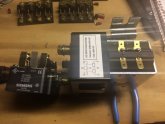Hello,
After recently coming across Wills videos i decided to upgrade my small system with a Victron 100/20 SCC but noticed that Will mentioned not to use the battery disconnect with the inverter. I tried to search but could not find anything so if its a repeat post i would appreciate it if you could point me in the right direction. My inverter does not have any remote connection so what options do i have to make have some sort of battery disconnect protection in place?
I just bought a new inverter so dont really want to buy another one but if thats the best option then i will do.
Thanks
After recently coming across Wills videos i decided to upgrade my small system with a Victron 100/20 SCC but noticed that Will mentioned not to use the battery disconnect with the inverter. I tried to search but could not find anything so if its a repeat post i would appreciate it if you could point me in the right direction. My inverter does not have any remote connection so what options do i have to make have some sort of battery disconnect protection in place?
I just bought a new inverter so dont really want to buy another one but if thats the best option then i will do.
Thanks



